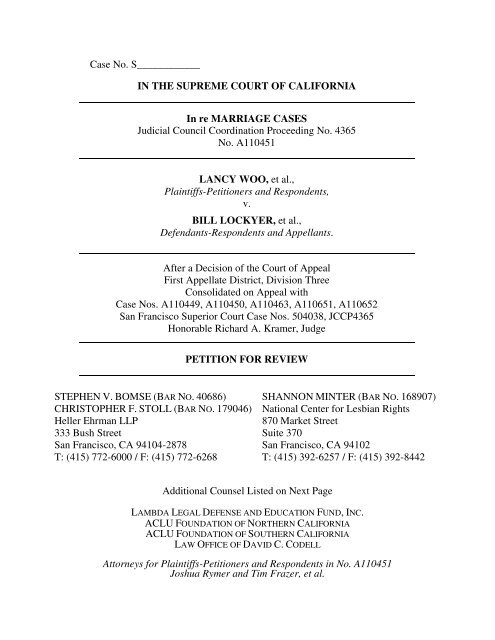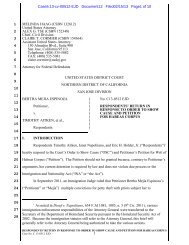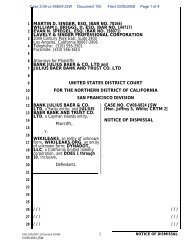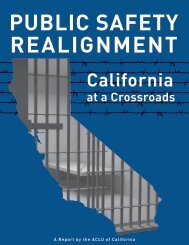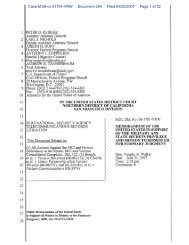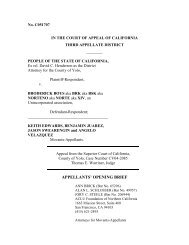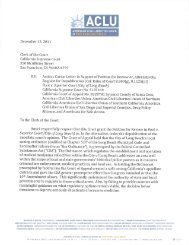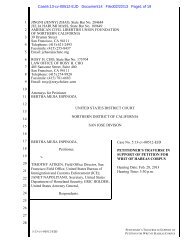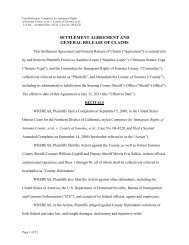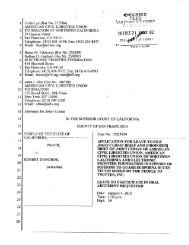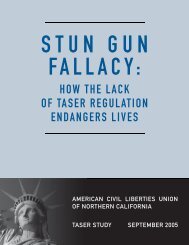Petition for Review - California Courts - State of California
Petition for Review - California Courts - State of California
Petition for Review - California Courts - State of California
Create successful ePaper yourself
Turn your PDF publications into a flip-book with our unique Google optimized e-Paper software.
Case No. S____________<br />
IN THE SUPREME COURT OF CALIFORNIA<br />
In re MARRIAGE CASES<br />
Judicial Council Coordination Proceeding No. 4365<br />
No. A110451<br />
LANCY WOO, et al.,<br />
Plaintiffs-<strong>Petition</strong>ers and Respondents,<br />
v.<br />
BILL LOCKYER, et al.,<br />
Defendants-Respondents and Appellants.<br />
After a Decision <strong>of</strong> the Court <strong>of</strong> Appeal<br />
First Appellate District, Division Three<br />
Consolidated on Appeal with<br />
Case Nos. A110449, A110450, A110463, A110651, A110652<br />
San Francisco Superior Court Case Nos. 504038, JCCP4365<br />
Honorable Richard A. Kramer, Judge<br />
PETITION FOR REVIEW<br />
STEPHEN V. BOMSE (BAR NO. 40686)<br />
CHRISTOPHER F. STOLL (BAR NO. 179046)<br />
Heller Ehrman LLP<br />
333 Bush Street<br />
San Francisco, CA 94104-2878<br />
T: (415) 772-6000 / F: (415) 772-6268<br />
SHANNON MINTER (BAR NO. 168907)<br />
National Center <strong>for</strong> Lesbian Rights<br />
870 Market Street<br />
Suite 370<br />
San Francisco, CA 94102<br />
T: (415) 392-6257 / F: (415) 392-8442<br />
Additional Counsel Listed on Next Page<br />
LAMBDA LEGAL DEFENSE AND EDUCATION FUND, INC.<br />
ACLU FOUNDATION OF NORTHERN CALIFORNIA<br />
ACLU FOUNDATION OF SOUTHERN CALIFORNIA<br />
LAW OFFICE OF DAVID C. CODELL<br />
Attorneys <strong>for</strong> Plaintiffs-<strong>Petition</strong>ers and Respondents in No. A110451<br />
Joshua Rymer and Tim Frazer, et al.
Additional Attorneys <strong>for</strong> Plaintiffs-<strong>Petition</strong>ers and<br />
Respondents in No. A110451<br />
Joshua Rymer and Tim Frazer, Jewelle Gomez and Diane Sabin,<br />
Myra Beals and Ida Matson, Arthur Frederick Adams and<br />
Devin Wayne Baker, Jeanne Rizzo and Pali Cooper,<br />
Karen Shain and Jody Sokolower, Janet Wallace and Deborah Hart,<br />
Corey Davis and Andre LeJeune, Rachel Lederman and Alexsis Beach,<br />
Stuart Gaffney and John Lewis, Phyllis Lyon and Del Martin,<br />
Our Family Coalition, and Equality Cali<strong>for</strong>nia:<br />
JON W. DAVIDSON (BAR NO. 89301)<br />
JENNIFER C. PIZER (BAR NO. 152327)<br />
LAMBDA LEGAL DEFENSE AND EDUCATION FUND, INC.<br />
3325 Wilshire Boulevard, Suite 1300<br />
Los Angeles, CA 90010<br />
T: (213) 382-7600 / F: (213) 351-6050<br />
CHRISTINE P. SUN (BAR NO. 218701)<br />
PETER J. ELIASBERG (BAR NO. 189110)<br />
ACLU FOUNDATION OF SOUTHERN CALIFORNIA<br />
1616 Beverly Boulevard<br />
Los Angeles, CA 90026<br />
T: (213) 977-9500 / F: (213) 250-3919<br />
TAMARA LANGE (BAR NO. 177949)<br />
ALAN L. SCHLOSSER (BAR NO. 49957)<br />
ACLU FOUNDATION OF NORTHERN CALIFORNIA<br />
39 Drumm Street<br />
San Francisco, CA 94111<br />
T: (415) 621-2493 / F: (415) 255-8437<br />
DAVID C. CODELL (BAR NO. 200965)<br />
LAW OFFICE OF DAVID C. CODELL<br />
9200 Sunset Boulevard, Penthouse Two<br />
Los Angeles, CA 90069<br />
T: (310) 273-0306 / F: (310) 273-0307
TABLE OF CONTENTS<br />
STATEMENT OF ISSUES PRESENTED ...................................................1<br />
WHY REVIEW SHOULD BE GRANTED .................................................1<br />
FACTUAL AND PROCEDURAL BACKGROUND..................................5<br />
LEGAL DISCUSSION .................................................................................8<br />
I. This Court Should Grant <strong>Review</strong> To Clarify How To Determine<br />
Whether A Classification Is Suspect And To Decide Whether Laws<br />
That Discriminate Based On Sexual Orientation Require Strict<br />
Scrutiny. .............................................................................................8<br />
A. The First Appellate District Announced An Approach To<br />
Suspect Class Analysis That Conflicts With This Court’s<br />
Precedents And That Will Cause Confusion Among <strong>State</strong><br />
<strong>Courts</strong>.........................................................................................10<br />
B. This Court Should Clarify That Laws That Discriminate Based<br />
On Sexual Orientation Are Subject To Strict Scrutiny. ............13<br />
II. This Court Should Grant <strong>Review</strong> To Preserve Strict Scrutiny Of<br />
Sex-Based Classifications Under The Cali<strong>for</strong>nia Constitution........14<br />
III. This Court Should Grant <strong>Review</strong> To Preserve Meaningful Rational<br />
Basis <strong>Review</strong> And To Determine Whether The Marriage Exclusion<br />
Advances Any Legitimate <strong>State</strong> Purpose. ........................................16<br />
IV. This Court Should Grant <strong>Review</strong> Because Consigning Lesbian And<br />
Gay Couples To A Separate And Lesser Status Violates Cali<strong>for</strong>nia’s<br />
Equal Protection Clause. ..................................................................19<br />
V. This Court Should Grant <strong>Review</strong> To Determine Whether The<br />
Fundamental Right To Marry The Person Of One’s Choice Is<br />
Guaranteed To Lesbian And Gay People Under The Cali<strong>for</strong>nia<br />
Constitution’s Due Process, Privacy, And Equal Protection<br />
Provisions. ........................................................................................23<br />
VI. This Court Should Grant <strong>Review</strong> To Determine Whether Excluding<br />
Lesbian And Gay Couples From Marriage Violates The Cali<strong>for</strong>nia<br />
Constitution’s Guarantee <strong>of</strong> Free Expression...................................26<br />
CONCLUSION ...........................................................................................28<br />
i
TABLE OF AUTHORITIES<br />
Cases<br />
Adoption <strong>of</strong> Kay C., (1991) 228 Cal.App.3d 741........................................17<br />
Amer. Acad. <strong>of</strong> Pediatrics v. Lungren (1997) 16 Cal.4th 307...............24, 25<br />
Baker v. <strong>State</strong> (1999) 744 A.2d 864 ............................................................15<br />
Bowens v. Superior Court (1991) 1 Cal. 4th 36 ..........................................10<br />
Citizens <strong>for</strong> Responsible Behavior v. Superior Court (1991) 1 Cal.App.4th<br />
1013 ...........................................................................................................9<br />
City <strong>of</strong> Cleburne v. Cleburne Living Center, Inc.<br />
(1985) 473 U.S. 432...........................................................................11, 18<br />
College Area Renters & Landlord Assn. v. City <strong>of</strong> San Diego, (1996) 43<br />
Cal. App. 4th 677.....................................................................................17<br />
Committee to Defend Reproductive Rights v. Myers<br />
(1981) 29 Cal.3d 252 ..............................................................................24<br />
Connerly v. <strong>State</strong> Personnel Bd. (2001) 92 Cal.App.4th 16 .................14, 15<br />
Conservatorship <strong>of</strong> Valerie N. (1985) 40 Cal.3d 143 ...........................23, 25<br />
Craig v. Boren, 429 U.S. 190 ......................................................................12<br />
D’Amico v. Bd, <strong>of</strong> Med. Exam’rs (1974) 11 Cal.3d 1 .................................16<br />
Darces v. Woods (1984) 35 Cal.3d 871.......................................................11<br />
Del Monte v. Wilson, (1992) 1 Cal.4th 1009...............................................16<br />
Frontiero v. Richardson (1973) 411 U.S. 677 ............................................12<br />
Gay Law Students Ass’n v. Pacific Tel. & Tel. Co. (1979) 24 Cal.3d 458....9<br />
Goodridge v. Dep’t <strong>of</strong> Public Health (Mass. 2003) 798 N.E.2d 941..........19<br />
ii
Hernandez-Montiel v. I.N.S. (9th Cir. 2000) 225 F.3d 1084.................12, 13<br />
Huntley v. Public Utilities Com. (1968) 69 Cal.2d 67 ................................27<br />
In re Gary W. (1971) 5 Cal.3d 296..............................................................17<br />
In re Rosenkrantz (2002) 29 Cal.4th 616 ....................................................16<br />
Keenan v. Superior Court (2002) 27 Cal.4th 413 .......................................27<br />
Knight v. Superior Court (2005) 128 Cal.App.4th 14.................................21<br />
Koebke v. Bernardo Heights Country Club (2005) 36 Cal.4th 824 ............19<br />
Lawrence v. Texas (2003) 539 U.S. 558 .....................................................24<br />
Lockyer v. City & County <strong>of</strong> San Francisco (2004) 33 Cal.4th 1055 .....3, 19<br />
Loving v. Virginia (1967) 388 U.S. 1 ............................................................4<br />
Newland v. Bd. <strong>of</strong> Governors (1977) 19 Cal.3d 705 ...................................16<br />
Opinions <strong>of</strong> the Justices to the Senate (Mass. 2004) 802 N.E.2d 565 ..20, 21<br />
People v. H<strong>of</strong>sheier, 37 Cal.App.4th 1185............................................16, 17<br />
Perez v. Sharp (1948) 32 Cal.2d 711 ..........................................4, 15, 23, 24<br />
Sail’er Inn v. Kirby (1971) 5 Cal.3d 1.............................................11, 12, 14<br />
Serrano v. Priest (1976) 18 Cal.3d 728.......................................................10<br />
Smelt v. County <strong>of</strong> Orange (9th Cir. 2006) 447 F.3d 673 ...........................21<br />
Turner v. Safley (1987) 482 U.S. 78................................................19, 25, 26<br />
United <strong>State</strong>s v. O’Brien (1968) 391 U.S. 367............................................27<br />
Velez v. Smith (2006) 142 Cal.App.4th 1154 ..............................................22<br />
Warden v. <strong>State</strong> Bar <strong>of</strong> Cali<strong>for</strong>nia (1999) 21 Cal.4th 628 ..........................17<br />
Watkins v. U.S. Army (9th Cir. 1989) 875 F.2d 699....................................11<br />
iii
Wiley v. County <strong>of</strong> San Diego (1998) 19 Cal.4th 532 .................................12<br />
Young v. Haines (1986) 41 Cal.3d 883 .......................................................16<br />
Zeitlin v. Arnebergh (1963) 59 Cal.2d 901 .................................................12<br />
Secondary Sources<br />
Peter Wallenstein, Tell the Court I Love My Wife: Race, Marriage, and<br />
Law — An American History (2002) .......................................................24<br />
Statues and Legislative Materials<br />
Assem. Bill 849, vetoed by Governor, Sept. 29, (2005-2006 Reg. Sess.) ..20<br />
Cal. Const., art. I, section 1 .........................................................................24<br />
Cal. Fam. Code § 300................................................................................6, 7<br />
Cal. Fam. Code § 301....................................................................................6<br />
Cal. Fam. Code § 308.5.............................................................................6, 7<br />
iv
STATEMENT OF ISSUES PRESENTED<br />
1. Does Cali<strong>for</strong>nia's statutory ban on marriage between two<br />
persons <strong>of</strong> the same sex violate the Cali<strong>for</strong>nia Constitution by denying<br />
equal protection <strong>of</strong> the laws, including on the bases <strong>of</strong> sexual orientation<br />
and sex, and by denying the right to due process, privacy, and freedom <strong>of</strong><br />
expression<br />
2. Should courts apply strict scrutiny under the Cali<strong>for</strong>nia<br />
Constitution to laws that discriminate based on sexual orientation<br />
WHY REVIEW SHOULD BE GRANTED 1<br />
This case presents some <strong>of</strong> the most pressing constitutional questions<br />
<strong>of</strong> our day — essential questions about the rights <strong>of</strong> lesbian and gay couples<br />
1 This <strong>Petition</strong> <strong>for</strong> <strong>Review</strong> is filed in Woo v. Lockyer, Court <strong>of</strong><br />
Appeal Case No. A110451, on behalf <strong>of</strong> the following parties, who were<br />
plaintiffs/petitioners in San Francisco Superior Court and respondents in<br />
the Court <strong>of</strong> Appeal: Joshua Rymer and Tim Frazer, Jewelle Gomez and<br />
Diane Sabin, Myra Beals and Ida Matson, Arthur Frederick Adams and<br />
Devin Wayne Baker, Jeanne Rizzo and Pali Cooper, Karen Shain and Jody<br />
Sokolower, Janet Wallace and Deborah Hart, Corey Davis and Andre<br />
LeJeune, Rachel Lederman and Alexsis Beach, Stuart Gaffney and John<br />
Lewis, Phyllis Lyon and Del Martin, Our Family Coalition, and Equality<br />
Cali<strong>for</strong>nia (hereinafter, “<strong>Petition</strong>ers”). <strong>Petition</strong>er Equality Cali<strong>for</strong>nia is<br />
simultaneously filing a <strong>Petition</strong> <strong>for</strong> <strong>Review</strong> in another <strong>of</strong> the consolidated<br />
marriage appeals, Tyler v. <strong>State</strong> <strong>of</strong> Cali<strong>for</strong>nia, Court <strong>of</strong> Appeal Case<br />
No. A110450, in which Equality Cali<strong>for</strong>nia was an intervenor<br />
plaintiff/petitioner in the Los Angeles Superior Court (and thereafter the<br />
San Francisco Superior Court) and a respondent in the Court <strong>of</strong> Appeal.<br />
With the exception <strong>of</strong> this footnote and the Factual and Procedural<br />
Background sections, the <strong>Petition</strong>s <strong>for</strong> <strong>Review</strong> in Nos. A110451 and<br />
A110450 are identical in substance. Two <strong>of</strong> the plaintiffs/petitioners and<br />
respondents in No. A110451, Lancy Woo and Cristy Chung, are not<br />
continuing as parties in this litigation <strong>for</strong> personal reasons unrelated to the<br />
merits <strong>of</strong> these constitutional challenges. They there<strong>for</strong>e have not joined<br />
this <strong>Petition</strong>.<br />
1
and their children, the state’s favored legal status <strong>of</strong> marriage, and the<br />
meaning <strong>of</strong> our state Constitution’s most cherished guarantees <strong>of</strong> equal<br />
protection, due process, privacy, and free expression. If allowed to stand,<br />
the First Appellate District’s resolution <strong>of</strong> those questions will be<br />
detrimental to the interests <strong>of</strong> hundreds <strong>of</strong> thousands <strong>of</strong> lesbian and gay<br />
people residing in Cali<strong>for</strong>nia and their families, as well as to others who<br />
seek to invoke the basic principles <strong>of</strong> equality, dignity, and liberty<br />
safeguarded by our state’s Constitution.<br />
In ruling that lesbian and gay couples may be excluded from<br />
marriage, the First Appellate District held that the Cali<strong>for</strong>nia Constitution is<br />
not <strong>of</strong>fended by the maintenance <strong>of</strong> a dual system <strong>of</strong> family law under<br />
which lesbian and gay couples and their children are relegated to a legal<br />
status (domestic partnership) separate from and lesser than the status that<br />
protects heterosexual couples and their children (marriage). The First<br />
Appellate District also held that government discrimination based on sexual<br />
orientation is subject only to an “extremely deferential” standard <strong>of</strong> review,<br />
despite an acknowledged history <strong>of</strong> invidious discrimination against lesbian<br />
and gay people, and despite Cali<strong>for</strong>nia’s well-settled public policy that<br />
sexual orientation is irrelevant not only to a person’s ability to participate in<br />
society and in family life, but to government decision-making in general.<br />
The First Appellate District further held that statutes that classify based on<br />
gender are not subject to strict scrutiny under the Cali<strong>for</strong>nia equal<br />
protection clause if they apply equally to both men and women as groups.<br />
In addition, the First Appellate District held that the government may<br />
restrict the exercise <strong>of</strong> important constitutional rights, even those deemed<br />
fundamental and protected by the due process and privacy guarantees <strong>of</strong> the<br />
Cali<strong>for</strong>nia Constitution, based on nothing more than a history <strong>of</strong> exclusion<br />
and bald deference to the majority’s desire to retain a right or privilege<br />
exclusively <strong>for</strong> itself.<br />
2
All <strong>of</strong> those holdings depart significantly from established<br />
constitutional tests and weaken the protections <strong>of</strong> core provisions <strong>of</strong> our<br />
state charter. This Court should grant review to safeguard the vitality and<br />
integrity <strong>of</strong> our state constitutional law and to prevent courts from applying<br />
the First Appellate District’s analyses in other contexts, to the disadvantage<br />
not only <strong>of</strong> lesbian and gay people, but also <strong>of</strong> other vulnerable groups.<br />
In a long line <strong>of</strong> judicial decisions and in a recent string <strong>of</strong> statutes,<br />
Cali<strong>for</strong>nia’s courts and Legislature repeatedly have emphasized that lesbian<br />
and gay people are entitled under the Cali<strong>for</strong>nia Constitution to equal<br />
protection <strong>of</strong> the law. That promise, however, rings hollow to lesbian and<br />
gay couples and their children when the law assigns their families to a<br />
separate legal status that indisputably is second-class and inferior to<br />
marriage.<br />
This Court should not permit another generation <strong>of</strong> lesbian and gay<br />
youth in Cali<strong>for</strong>nia to grow up unable to dream <strong>of</strong> “obtain[ing] the public<br />
validation that only marriage can give.” (Lockyer v. City & County <strong>of</strong> San<br />
Francisco (2004) 33 Cal.4th 1055, 1132 (conc. and dis. opn. <strong>of</strong> Kennard,<br />
J.).) Nor should this Court permit Cali<strong>for</strong>nia statutory law to continue to<br />
tell not only lesbian and gay people, but also their neighbors, employers,<br />
friends, relatives, and government actors that sexual orientation is a valid<br />
basis <strong>for</strong> distinguishing between families. By doing so, the state invites<br />
discrimination based on a characteristic that the Legislature and the courts<br />
have otherwise emphasized has no bearing on the ability <strong>of</strong> Cali<strong>for</strong>nians to<br />
contribute to society or to <strong>for</strong>m loving and lasting family relationships.<br />
During the last sixty years, the Cali<strong>for</strong>nia Supreme Court has led this<br />
nation in enunciating what is encompassed in constitutional guarantees <strong>of</strong><br />
equal protection, due process, privacy, and free expression. In 1948, this<br />
Court was the first high court in the country’s history to recognize that laws<br />
banning marriage between persons <strong>of</strong> different races are unconstitutional.<br />
3
(See Perez v. Sharp (1948) 32 Cal.2d 711.) Nineteen years passed be<strong>for</strong>e<br />
another appellate court in this nation agreed — the United <strong>State</strong>s Supreme<br />
Court, with a <strong>for</strong>mer Cali<strong>for</strong>nia Governor sitting as Chief Justice. (See<br />
Loving v. Virginia (1967) 388 U.S. 1.) Similarly, Cali<strong>for</strong>nia’s Legislature<br />
and courts have been beacons to the rest <strong>of</strong> the United <strong>State</strong>s in ensuring<br />
that constitutional guarantees apply equally to all people regardless <strong>of</strong> their<br />
sexual orientation or gender.<br />
Contrary to the suggestion <strong>of</strong> the First Appellate District, the courts<br />
do not step ahead <strong>of</strong> the public by giving full effect to the Constitution’s<br />
central guarantees <strong>of</strong> equal protection, due process, privacy, and free<br />
expression. Rather, the Constitution sets <strong>for</strong>th a transcendent expression <strong>of</strong><br />
public will that the courts fulfill their essential role, as part <strong>of</strong> our tripartite<br />
government structure <strong>of</strong> checks and balances, to keep legislative edicts and<br />
even popular vote in line with our state’s most fundamental law.<br />
Accordingly, hundreds <strong>of</strong> thousands <strong>of</strong> lesbian and gay Cali<strong>for</strong>nians,<br />
as well as their children, are now depending on this Court to consider the<br />
claims that <strong>Petition</strong>ers here bring. <strong>Petition</strong>ers’ claims have been considered<br />
by four state court judges, two <strong>of</strong> whom (the Superior Court judge and the<br />
dissenter at the First Appellate District) concluded that the exclusion <strong>of</strong><br />
lesbian and gay couples from marriage violates our state Constitution. That<br />
split <strong>of</strong> opinion warrants this Court’s review. Moreover, given that the<br />
Judicial Council ordered all six marriage cases pending in the state courts<br />
coordinated into a single proceeding and given that the First Appellate<br />
District consolidated the appeals from the six judgments entered by the<br />
Superior Court, no other cases are likely to present the questions framed<br />
here. The state is looking to this Court <strong>for</strong> guidance, as the First Appellate<br />
District expressly acknowledged in its decision. (Opn. at p. 45.) Indeed,<br />
the Legislature recently determined that denying same-sex couples the right<br />
to marry discriminates on the bases <strong>of</strong> sex and sexual orientation in<br />
4
violation <strong>of</strong> the Cali<strong>for</strong>nia Constitution and voted to end the exclusion <strong>of</strong><br />
lesbian and gay couples from marriage. Because Governor<br />
Schwarzenegger referred to the pendency <strong>of</strong> this very litigation in his<br />
message vetoing that measure, Cali<strong>for</strong>nia’s lesbian and gay couples now<br />
confront a potential stalemate among the three co-equal branches <strong>of</strong><br />
Cali<strong>for</strong>nia’s government, making review by this Court essential.<br />
As more fully explained below, <strong>Petition</strong>ers respectfully request that<br />
this Court grant review <strong>of</strong> the First Appellate District’s decision in order to<br />
reverse that decision and to hold that, because Cali<strong>for</strong>nia’s exclusion <strong>of</strong><br />
lesbian and gay couples from marriage serves no legitimate, much less<br />
compelling, state interest, that exclusion violates the solemn guarantees <strong>of</strong><br />
the Cali<strong>for</strong>nia Constitution.<br />
FACTUAL AND PROCEDURAL BACKGROUND<br />
<strong>Petition</strong>ers in this action are: (a) twenty-two individuals who wish to<br />
marry in Cali<strong>for</strong>nia and are eligible to do so, but <strong>for</strong> the fact that they are<br />
members <strong>of</strong> same-sex couples; 2 (b) Our Family Coalition, a San Francisco<br />
Bay Area organization dedicated to promoting the civil rights and wellbeing<br />
<strong>of</strong> families with lesbian, gay, bisexual, and transgender members; and<br />
(c) Equality Cali<strong>for</strong>nia, the leading statewide advocacy organization <strong>for</strong><br />
lesbian, gay, bisexual, and transgender Cali<strong>for</strong>nians and their families.<br />
(Respondents’ Appendix, Case No. A110451, p. 181 (hereinafter “RA”).)<br />
<strong>Petition</strong>ers filed this action on March 12, 2004 in San Francisco<br />
Superior Court. <strong>Petition</strong>ers’ Third Amended <strong>Petition</strong> <strong>for</strong> Writ <strong>of</strong> Mandate<br />
and Complaint <strong>for</strong> Declaratory and Injunctive Relief sought relief against<br />
the state <strong>of</strong> Cali<strong>for</strong>nia and state <strong>of</strong>ficials that would permit same-sex<br />
2 All <strong>Petition</strong>ers are listed by name in footnote 1 above.<br />
5
couples to marry. (RA at pp. 194-195, 203-206.) In particular, <strong>Petition</strong>ers<br />
requested that sections 300, 301, and 308.5 3 <strong>of</strong> the Family Code be<br />
construed to permit same-sex couples to marry or be declared<br />
unconstitutional and that corresponding injunctive and writ relief be issued.<br />
(RA at pp. 203-206.)<br />
This case was coordinated with five other actions be<strong>for</strong>e San<br />
Francisco Superior Court Judge Richard A. Kramer. (Appellants’<br />
Appendix, Case No. A110451, p. 107 (hereinafter “AA”).) Judge Kramer<br />
held a hearing in all six marriage cases on December 22 and 23, 2004. (AA<br />
at pp. 108-109.) On April 13, 2005, Judge Kramer issued a Final Decision,<br />
ruling that sections 300 and 308.5 <strong>of</strong> the Family Code violate the Cali<strong>for</strong>nia<br />
Constitution’s equal protection guarantee because they lack a rational basis<br />
and because they discriminate based on sex and violate the fundamental<br />
right to marry without serving a compelling state interest. (AA at pp. 107-<br />
131.) Judge Kramer issued separate judgments in the coordinated cases.<br />
(AA at pp. 134-205.) In the present action, Judge Kramer entered judgment<br />
granting <strong>Petition</strong>ers declaratory relief corresponding to Judge Kramer’s<br />
3 Section 308.5 codified Proposition 22, which was enacted by the<br />
voters in 2000 to ensure that Cali<strong>for</strong>nia would not be required to honor<br />
marriages contracted by same-sex couples in other jurisdictions. Although<br />
the First Appellate District saw no need to decide whether section 308.5<br />
also applies to in-state marriages, Judge Kramer's opinion concluded that<br />
section 308.5's sole "purpose as articulated to the voters was to preclude the<br />
recognition in Cali<strong>for</strong>nia <strong>of</strong> same-sex marriages consummated outside <strong>of</strong><br />
this state." (AA, pp. 117-118.) This issue was briefed at length in the<br />
Court <strong>of</strong> Appeal and is fairly presented in the first Issue Presented in this<br />
<strong>Petition</strong>. (See Respondent Intervenor Equality Cali<strong>for</strong>nia's Answer Brief,<br />
Case No. A110450 (dated Nov. 21, 2005), pp. 5-12; Respondents'<br />
Corrected Answer Brief, Case No. A110451 (dated Nov. 10, 2005), pp. 17-<br />
18, 19, fn. 10.)<br />
6
Final Decision in the case (AA at pp. 138-141) and issued a writ <strong>of</strong><br />
mandate to the <strong>State</strong> Registrar <strong>of</strong> Vital Statistics (AA at pp. 149-152).<br />
The state defendants appealed, and the Court <strong>of</strong> Appeal, First<br />
Appellate District, Division Three, ordered all six marriage cases<br />
consolidated <strong>for</strong> purposes <strong>of</strong> decision. (Opn. at p. 7.) On October 5, 2006,<br />
the First Appellate District issued a decision in all six appeals, which<br />
included an unqualified reversal <strong>of</strong> the Superior Court’s judgment in this<br />
case. In its decision, certified <strong>for</strong> publication, the First Appellate District<br />
held that sections 300 and 308.5 <strong>of</strong> the Family Code do not violate the<br />
equal protection, due process, privacy, or free expression guarantees <strong>of</strong> the<br />
Cali<strong>for</strong>nia Constitution. 4 Presiding Justice J. Anthony Kline dissented,<br />
arguing that the statutory ban on marriage by same-sex couples violates the<br />
Cali<strong>for</strong>nia Constitution’s equal protection, due process, and privacy<br />
provisions.<br />
On October 19, 2006, <strong>Petition</strong>ers filed a petition <strong>for</strong> rehearing. On<br />
Monday, November 6, 2006, the First Appellate District issued an order<br />
denying the petition <strong>for</strong> rehearing and modifying its opinion without<br />
affecting the judgment. The First Appellate District’s decision became<br />
final on Saturday, November 4, 2006.<br />
4 In two <strong>of</strong> the consolidated appeals, Nos. A110651 and A110652,<br />
the Court <strong>of</strong> Appeal affirmed the Superior Court’s dismissal <strong>of</strong> the actions<br />
brought by Proposition 22 Legal Defense and Education Fund and the<br />
Campaign <strong>for</strong> Cali<strong>for</strong>nia Families, respectively. The Court <strong>of</strong> Appeal ruled<br />
that those parties lacked standing. Some <strong>of</strong> the <strong>Petition</strong>ers were interveners<br />
in those two cases, but do not seek review <strong>of</strong> the Court <strong>of</strong> Appeal’s rulings<br />
regarding lack <strong>of</strong> justiciability in those two cases.<br />
7
LEGAL DISCUSSION<br />
I. This Court Should Grant <strong>Review</strong> To Clarify How To Determine<br />
Whether A Classification Is Suspect And To Decide Whether<br />
Laws That Discriminate Based On Sexual Orientation Require<br />
Strict Scrutiny.<br />
Although the First Appellate District correctly concluded that<br />
Cali<strong>for</strong>nia’s statutory exclusion <strong>of</strong> same-sex couples from marriage<br />
discriminates on the basis <strong>of</strong> sexual orientation (opn. at pp. 38-40), 5<br />
mistakenly held that the marriage exclusion could withstand constitutional<br />
challenge if there were any rational basis supporting it. The First Appellate<br />
District’s conclusion rested on that court’s erroneous pronouncement – the<br />
first <strong>of</strong> its kind by a Cali<strong>for</strong>nia appellate court – that laws that discriminate<br />
based on sexual orientation are subject only to the lowest level <strong>of</strong> review<br />
under the Cali<strong>for</strong>nia equal protection clause. That holding departed from<br />
this Court’s established approach <strong>for</strong> determining whether a classification<br />
should be treated as suspect. Because the First Appellate District’s holding<br />
will be binding on all trial courts throughout the state absent this Court’s<br />
review, it is essential that this Court grant review. The level <strong>of</strong> scrutiny<br />
applicable to sexual orientation discrimination is a general question <strong>of</strong><br />
statewide importance that applies not only to the marriage issue presented<br />
in these cases, but to all governmental actions that discriminate against<br />
lesbian and gay people. Moreover, how to determine whether to apply<br />
strict scrutiny to laws that discriminate against a class <strong>of</strong> people is a basic<br />
constitutional question affecting not only lesbian and gay people, but also<br />
it<br />
5 The First Appellate District described the marriage exclusion as<br />
having a disparate impact on lesbian and gay couples. <strong>Petition</strong>ers contend<br />
that the statutory marriage exclusion also facially discriminates on the basis<br />
<strong>of</strong> sexual orientation.<br />
8
other vulnerable groups who seek constitutional protection from<br />
discriminatory government action.<br />
Although this Court has not articulated whether laws that<br />
discriminate based on sexual orientation are subject to strict scrutiny under<br />
the Cali<strong>for</strong>nia Constitution, both this Court and other Cali<strong>for</strong>nia courts<br />
routinely have struck down such laws under the state equal protection<br />
clause. (See, e.g., Gay Law Students Ass’n v. Pacific Tel. & Tel. Co. (1979)<br />
24 Cal.3d 458, 474-475; Citizens <strong>for</strong> Responsible Behavior v. Superior<br />
Court (1991) 1 Cal.App.4th 1013, 1025-1026.) In analyzing the marriage<br />
statutes, however, the First Appellate District incorrectly held that it was<br />
required to apply only rational basis review because <strong>of</strong> the lack <strong>of</strong> an<br />
express statement by this Court or by other Cali<strong>for</strong>nia <strong>Courts</strong> <strong>of</strong> Appeal that<br />
laws discriminating based on sexual orientation warrant strict scrutiny.<br />
(Opn. at p. 45.)<br />
The limited analysis that the First Appellate District <strong>of</strong>fered in<br />
pronouncing sexual orientation unworthy <strong>of</strong> treatment as a suspect<br />
classification conflicts with this Court’s established precedents in numerous<br />
respects and will likely cause confusion <strong>for</strong> trial courts throughout the state.<br />
The First Appellate District erroneously (1) held that several factors<br />
described by this Court as relevant to suspect classification analysis are<br />
necessary requirements rather than factors to be considered; (2) specifically<br />
held that immutability (which it suggested may be limited to the question <strong>of</strong><br />
genetic or biological causation) is a requirement <strong>for</strong> treatment as a suspect<br />
classification; and (3) held that whether a trait is immutable is not a legal<br />
issue, but a factual question requiring an evidentiary hearing or trial court<br />
findings. This Court should grant review to confirm the continuing validity<br />
<strong>of</strong> this Court’s previously enunciated analysis <strong>for</strong> deciding when strict<br />
scrutiny is required and to clarify that classifications based on sexual<br />
orientation demand such scrutiny.<br />
9
A. The First Appellate District Announced An Approach To<br />
Suspect Class Analysis That Conflicts With This Court’s<br />
Precedents And That Will Cause Confusion Among <strong>State</strong><br />
<strong>Courts</strong>.<br />
In determining whether laws that classify on a particular basis<br />
should be subject to strict scrutiny under the Cali<strong>for</strong>nia Constitution, this<br />
Court has considered a number <strong>of</strong> factors designed to identify<br />
classifications that are likely to be based on invidious rather than legitimate<br />
bases. “The determination <strong>of</strong> whether a suspect class exists focuses on<br />
whether ‘[t]he system <strong>of</strong> alleged discrimination and the class it defines have<br />
[any] <strong>of</strong> the traditional indicia <strong>of</strong> suspectness: [such as a class] saddled with<br />
such disabilities, or subjected to such a history <strong>of</strong> purposeful unequal<br />
treatment, or relegated to such a position <strong>of</strong> political powerlessness as to<br />
command extraordinary protection from the majoritarian political<br />
process.’” (Bowens v. Superior Court (1991) 1 Cal.4th 36, 42 (citation<br />
omitted) (bracketed modifications in original).) Contrary to the First<br />
Appellate District’s overly rigid approach, this Court has treated these<br />
factors as considerations, rather than mechanically treating each as an<br />
absolute requirement. Thus, a group need not manifest all <strong>of</strong> these factors<br />
in order <strong>for</strong> laws affecting the group to warrant strict scrutiny.<br />
In particular, contrary to the First Appellate District’s decision, this<br />
Court has never held that only classifications based on immutable traits can<br />
be deemed suspect. Indeed, in the Court’s most recent discussion <strong>of</strong> the<br />
“indicia <strong>for</strong> suspectness,” the Court did not mention immutability. (See<br />
Bowens, supra, 1 Cal.4th at 42; see also e.g. Serrano v. Priest (1976) 18<br />
Cal.3d 728 [holding school district wealth to be a suspect classification<br />
under the state equal protection clause without any reference to<br />
immutability].) When this Court has referred to immutability as a relevant<br />
10
factor, it has done so only in passing, with little or no discussion, and has<br />
focused its analysis on other factors with a more direct bearing on whether<br />
the discrimination at issue is invidious. (See, e.g., Sail’er Inn v. Kirby<br />
(1971) 5 Cal.3d 1, 18 [“What differentiates sex from nonsuspect statuses,<br />
such as intelligence or physical disability, and aligns it with the recognized<br />
suspect classifications is that the characteristic frequently bears no relation<br />
to ability to per<strong>for</strong>m or contribute to society.”].) Similarly, the United<br />
<strong>State</strong>s Supreme Court has “never held that only classes with immutable<br />
traits can be deemed suspect.” (Watkins v. U.S. Army (9th Cir. 1989) 875<br />
F.2d 699, 725 (conc. opn. <strong>of</strong> Norris, J.) (citations omitted).) Thus, the First<br />
Appellate District was wrong to treat immutability as a necessary or<br />
talismanic factor in determining whether strict scrutiny applies to a<br />
particular <strong>for</strong>m <strong>of</strong> discrimination. The First Appellate District’s error in<br />
this regard will cause confusion not only with respect to sexual orientation,<br />
but perhaps even with regard to some classifications that the courts<br />
previously have treated as suspect.<br />
Moreover, even if immutability were a necessary criterion, the First<br />
Appellate District acknowledged that there is no consensus on what such a<br />
requirement would encompass – that is, whether immutability is limited to<br />
traits that are “genetic” or “biological.” (See opn. at p. 44, fn. 27; id. at p. 6<br />
(conc. opn. <strong>of</strong> Parrilli, J.) [“[I]f being gay or lesbian is an immutable trait or<br />
biologically determined, then we must conclude classification based on that<br />
status which deprives such persons <strong>of</strong> legitimate rights is suspect.”]<br />
(emphasis in original).) In many equal protection decisions, immutability<br />
does not require a genetic or biological basis; rather, immutability refers to<br />
a characteristic that is “beyond the individual’s control.” (City <strong>of</strong> Cleburne<br />
v. Cleburne Living Center, Inc. (1985) 473 U.S. 432, 441; Darces v. Woods<br />
(1984) 35 Cal.3d 871, 892-893.) Furthermore, immutability does not mean<br />
an absolute inability to change the class trait. Children can be legitimated;<br />
11
aliens can become naturalized; and individuals can change their sex. Thus,<br />
the concept <strong>of</strong> immutability encompasses characteristics that an individual<br />
“should not be required to change because [they are] fundamental to . . .<br />
individual identities or consciences.” (Hernandez-Montiel v. I.N.S. (9th<br />
Cir. 2000) 225 F.3d 1084, 1092.)<br />
Finally, contrary to the First Appellate District’s decision, whether a<br />
particular classification should be subject to strict scrutiny is a legal<br />
question, not a factual question requiring an evidentiary hearing or trial<br />
court factual findings. (Opn. at pp. 44-45; see, e.g., Sail’er Inn, supra<br />
[deciding that sex is a suspect classification under the Cali<strong>for</strong>nia<br />
Constitution as a legal, rather, than a factual matter]; Frontiero v.<br />
Richardson (1973) 411 U.S. 677 [same under federal Constitution]; see also<br />
Craig v. Boren, 429 U.S. 190, 204 [“[P]roving broad sociological<br />
propositions by statistics is a dubious business, and one that inevitably is in<br />
tension with the normative philosophy that underlies the Equal Protection<br />
Clause.”].) If this were not so, different trial courts might well reach<br />
different conclusions about whether a particular classification is suspect<br />
based on the evidence presented in a particular case, thereby leading to<br />
inconsistent results. (Cf. Zeitlin v. Arnebergh (1963) 59 Cal.2d 901, 908-<br />
909 [“[Q]uestions <strong>of</strong> . . . constitutional construction and application call <strong>for</strong><br />
court decisions; they raise issues, not <strong>of</strong> the ascertainment <strong>of</strong> historical fact,<br />
but the definition <strong>of</strong> . . . constitutional protection; the court itself must<br />
determine the law <strong>of</strong> the case <strong>for</strong> the sake <strong>of</strong> consistent interpretation <strong>of</strong> . . .<br />
[constitutional issues].”].) 6 This Court should grant review to clarify <strong>for</strong><br />
6 Because the First Appellate District issued an unqualified reversal,<br />
if this Court does not grant review, this case will return to the superior court<br />
<strong>for</strong> a trial on the issue <strong>of</strong> immutability, as well as on any other issues on<br />
which the parties or the trial court may determine that presentation <strong>of</strong><br />
evidence is appropriate. (See Wiley v. County <strong>of</strong> San Diego (1998) 19<br />
Cal.4th 532, 545, fn. 4 [holding that an unqualified reversal “has the effect<br />
12
courts throughout the state that determining whether a classification<br />
warrants strict scrutiny need not hinge on factual evidence presented at a<br />
hearing in a particular case.<br />
B. This Court Should Clarify That Laws That Discriminate<br />
Based On Sexual Orientation Are Subject To Strict<br />
Scrutiny.<br />
The First Appellate District’s holding that laws that discriminate<br />
based on sexual orientation are subject to the lowest level <strong>of</strong> constitutional<br />
review lacks support from this Court’s precedents and, absent this Court’s<br />
review, will be harmful in adjudication <strong>of</strong> all sexual orientation<br />
discrimination claims, not simply the question whether lesbian and gay<br />
couples should be permitted to marry.<br />
The First Appellate District<br />
conceded that sexual orientation is irrelevant to a person’s ability to<br />
contribute to society and that lesbian and gay people have experienced a<br />
“history <strong>of</strong> legal and social disabilities,” but rested its rational basis holding<br />
on a purportedly unclear factual record on whether sexual orientation is an<br />
immutable trait. (Opn. at p. 45.)<br />
Even were immutability a requirement <strong>for</strong> strict scrutiny, however,<br />
sexual orientation would be immutable <strong>for</strong> purposes <strong>of</strong> equal protection,<br />
given that sexual orientation is a trait “so fundamental to one’s identity that<br />
a person should not be required to abandon” it. (Hernandez-Montiel, supra,<br />
225 F.3d at p. 1093 [“Sexual orientation and sexual identity are immutable;<br />
<strong>of</strong> remanding the cause <strong>for</strong> a new trial on all <strong>of</strong> the issues presented by the<br />
pleadings” and “leave[s] that case ‘at large’ <strong>for</strong> further proceedings as if it<br />
had never been tried”] (citations omitted).) As explained in the text,<br />
however, no such evidentiary hearing should be required on the suspect<br />
classification issue, and to avoid potential law-<strong>of</strong>-the-case problems, this<br />
Court should grant review now.<br />
13
they are so fundamental to one’s identity that a person should not be<br />
required to abandon them.”].) Indeed, the Cali<strong>for</strong>nia Constitution’s due<br />
process and privacy clauses protect one’s choice <strong>of</strong> sexual partner or life<br />
partner, and the state has no legitimate interest in requiring any Cali<strong>for</strong>nian<br />
to change his or her sexual orientation. Even were this not so,<br />
immutability is not a talismanic requirement <strong>of</strong> suspect classification<br />
analysis, as discussed above. Given the importance <strong>of</strong> protecting lesbian<br />
and gay Cali<strong>for</strong>nians from discrimination, this Court should review the<br />
First Appellate District’s plainly erroneous analysis and its conclusion that<br />
laws that discriminate based on sexual orientation are subject to “extremely<br />
deferential” review. (Opn. at p. 51.)<br />
II.<br />
This Court Should Grant <strong>Review</strong> To Preserve Strict Scrutiny Of<br />
Sex-Based Classifications Under The Cali<strong>for</strong>nia Constitution.<br />
In contrast to a number <strong>of</strong> other states and to the federal government,<br />
Cali<strong>for</strong>nia has long subjected sex-based classifications to strict scrutiny<br />
under the Cali<strong>for</strong>nia Constitution. (Sail’er Inn, supra, 5 Cal.3d at pp. 17-<br />
19.) Prior to the First Appellate District’s decision, however, no appellate<br />
court had held that the right to be free from sex discrimination under the<br />
Cali<strong>for</strong>nia equal protection clause belongs only to men and women as<br />
groups, not to individuals. (Opn. at p. 34.) The implications <strong>of</strong> the First<br />
Appellate District’s ruling on this issue, if permitted to stand, would create<br />
an unprecedented “equal application” loophole in Cali<strong>for</strong>nia’s equal<br />
protection jurisprudence.<br />
Cali<strong>for</strong>nia courts have made plain that the relevant inquiry under the<br />
Cali<strong>for</strong>nia equal protection clause is whether the law treats an individual<br />
differently because <strong>of</strong> his or her gender. (Connerly v. <strong>State</strong> Personnel Bd.<br />
(2001) 92 Cal.App.4th 16, 46 [holding that “the guarantee <strong>of</strong> equal<br />
protection is an individual right”].) In the context <strong>of</strong> marriage, in<br />
14
particular, this Court has stressed the importance <strong>of</strong> the principle that the<br />
right <strong>of</strong> equal protection belongs to the individual. (Perez v. Sharp, supra,<br />
32 Cal.2d at p. 716.)<br />
Despite these principles, the First Appellate District held that a law<br />
that expressly classifies based on sex does not trigger heightened scrutiny if<br />
it does not disadvantage either men or women as a group. (Opn. at p. 34.)<br />
In reaching this conclusion, the First Appellate District relied on a prior<br />
decision by the Third Appellate District, stating that a statute may<br />
“mention” sex or race without triggering strict scrutiny. (Opn. at pp. 34-35<br />
[citing Connerly, supra, 92 Cal.App.4th at p. 45].) The classification in<br />
Family Code Section 300, however, does much more than simply<br />
“mention” sex; it expressly employs sex to restrict the right to marry based<br />
on one’s sex and on the sex <strong>of</strong> one’s partner, specifying that a man can<br />
marry only a woman and a woman can marry only a man. (See Connerly,<br />
supra, 92 Cal.App.4th at p. 44 [“Where a statutory scheme, on its face,<br />
employs a suspect classification, the scheme is, on its face, in conflict with<br />
the core prohibition <strong>of</strong> the equal protection clause.”] (citation omitted).)<br />
From an individual’s perspective, this restriction is not gender-neutral. For<br />
example, <strong>Petition</strong>er Del Martin is prohibited from marrying the woman she<br />
has been with <strong>for</strong> more than fifty years because Del is a woman rather than<br />
a man. That the classification applies to and restricts the rights <strong>of</strong> both men<br />
and women as such compounds the constitutional violation; it does not<br />
remedy it. As Justice Johnson <strong>of</strong> the Vermont Supreme Court noted, if a<br />
sex-based classification did not trigger heightened scrutiny merely because<br />
it applied equally to men and woman as groups, then “a statute that required<br />
courts to give custody <strong>of</strong> male children to fathers and female children to<br />
mothers would not be sex discrimination.” (Baker v. <strong>State</strong> (1999) 744 A.2d<br />
864, 906, fn. 10 (conc. and dis. opn. <strong>of</strong> Johnson, J.).) Similarly, under the<br />
First Appellate District’s reasoning a statute that restricted business<br />
15
partnerships based on sex – <strong>for</strong> example, providing that in a given field<br />
women could enter into business partnerships only with other women and<br />
men only with other men — would not constitute sex discrimination. This<br />
Court should grant review to ensure that the Cali<strong>for</strong>nia Constitution’s<br />
protection <strong>of</strong> the individual’s right to be free from sex discrimination is not<br />
compromised by an “equal application” exception to strict scrutiny <strong>for</strong><br />
gender classifications.<br />
III.<br />
This Court Should Grant <strong>Review</strong> To Preserve Meaningful<br />
Rational Basis <strong>Review</strong> And To Determine Whether The<br />
Marriage Exclusion Advances Any Legitimate <strong>State</strong> Purpose.<br />
Prior to the First Appellate District’s decision, Cali<strong>for</strong>nia courts had<br />
never held that rational basis review under the Cali<strong>for</strong>nia Constitution is<br />
“extremely deferential.” 7 (Opn. at p. 51.) Rather, this Court has made clear<br />
that, even under rational basis review, courts must find that a classification<br />
has a legitimate and “plausible” rationale and “must undertake . . . a serious<br />
and genuine judicial inquiry into the correspondence between the<br />
classification and the legislative goals.” (People v. H<strong>of</strong>sheier, 37<br />
Cal.App.4th 1185, 1200 (2006) (original italics, citation omitted); Young v.<br />
Haines (1986) 41 Cal.3d 883, 900 [stating rational basis review under<br />
Cali<strong>for</strong>nia Constitution “is not toothless”].) If permitted to stand, the First<br />
Appellate District’s overly deferential application <strong>of</strong> rational basis review<br />
will mark a significant erosion <strong>of</strong> constitutional protections not only <strong>for</strong><br />
lesbians and gay men, but <strong>for</strong> all who depend upon rational basis review <strong>for</strong><br />
protection against arbitrary discrimination. (See, e.g., Del Monte v. Wilson<br />
(1992) 1 Cal.4th 1009 [veterans]; Newland v. Bd. <strong>of</strong> Governors (1977) 19<br />
7<br />
The only standard <strong>of</strong> judicial review this Court has termed<br />
“extremely deferential” is that applied to gubernatorial parole decisions.<br />
(See In re Rosenkrantz (2002) 29 Cal.4th 616, 665.)<br />
16
Cal.3d 705 [persons with prior convictions]; D’Amico v. Bd, <strong>of</strong> Med.<br />
Exam’rs (1974) 11 Cal.3d 1 [persons seeking occupational licenses];<br />
College Area Renters & Landlord Assn. v. City <strong>of</strong> San Diego, (1996) 43<br />
Cal. App. 4th 677 [tenants]); Adoption <strong>of</strong> Kay C., (1991) 228 Cal.App.3d<br />
741 [children with mental disabilities].) Indeed, review by this Court is<br />
essential to ensure that Cali<strong>for</strong>nia’s equal protection clause continues to<br />
provide meaningful protection to all Cali<strong>for</strong>nians.<br />
The First Appellate District failed to require any legitimate purpose<br />
<strong>for</strong> the state’s exclusion <strong>of</strong> all lesbian and gay couples from marriage. In<br />
determining whether a legislative exclusion survives rational basis review,<br />
a court must determine not only whether there is a reason to protect those<br />
persons included within the statute, but also whether there is a rational basis<br />
<strong>for</strong> the exclusion.. (H<strong>of</strong>sheier, supra, 37 Cal.App.4th at p. 1198; In re Gary<br />
W. (1971) 5 Cal.3d 296, 303 [“The state may not . . . arbitrarily accord<br />
privileges to . . . one class unless some rational distinction between those<br />
included in and those excluded from the class exists.”].) Even under<br />
rational basis review, which permits the government to address problems in<br />
piecemeal fashion, the state must have a legitimate reason <strong>for</strong> where it<br />
draws its lines. (H<strong>of</strong>sheier, supra, 37 Cal.4th at 1205, fn. 8 [“[W]hen the<br />
legislative body proposes to address an area <strong>of</strong> concern in less than<br />
comprehensive fashion by striking the evil where it is felt most, its decision<br />
as to where to strike must have a rational basis in light <strong>of</strong> the legislative<br />
objectives.”] (citations omitted).) This is especially true when a statute<br />
targets a disfavored group. (See, e.g., Warden v. <strong>State</strong> Bar <strong>of</strong> Cali<strong>for</strong>nia<br />
(1999) 21 Cal.4th 628, 649, fn. 13 [holding that the leeway generally<br />
extended to the legislature under rational basis does not apply where the<br />
classification targets a “class <strong>of</strong> persons characterized by some unpopular<br />
trait or affiliation”] (internal quotation marks and citation omitted).)<br />
17
Despite these precedents, the First Appellate District erroneously<br />
held that the state’s desire to “preserve[e] the institution <strong>of</strong> marriage in its<br />
historical opposite-sex <strong>for</strong>m” is a legitimate state interest. (Opn. at p. 59.)<br />
If mere deference to past practices or to history alone were sufficient to<br />
provide a legitimate basis <strong>for</strong> differential treatment, however, disfavored<br />
groups would have no protection against even the most irrational or<br />
arbitrary treatment. As the trial court in this case held: “The <strong>State</strong>’s<br />
protracted denial <strong>of</strong> equal protection cannot be justified simply because<br />
such constitutional violation has become traditional.” (AA at p. 113.)<br />
In addition, the First Appellate District held that, while<br />
“[m]ajoritarian whims or prejudices will never be sufficient to sustain a law<br />
that deprives individuals <strong>of</strong> a fundamental right or discriminates against a<br />
suspect class,” mere deference to majority will is a legitimate state interest<br />
under rational basis review. (Opn. at p. 61.) This Court should grant<br />
review to clarify that, under any level <strong>of</strong> scrutiny, a majority’s bare desire<br />
to retain a right or privilege <strong>for</strong> itself alone is never a legitimate public<br />
interest. Were it otherwise, no statute could ever be invalidated under<br />
rational basis review because it always would reflect the majority’s desire<br />
to preserve a particular <strong>for</strong>m <strong>of</strong> discrimination, however arbitrary or unfair.<br />
(See, e.g., City <strong>of</strong> Cleburne, supra, 473 U.S. at p. 448 [holding that even<br />
under rational basis review, the government “may not avoid the strictures <strong>of</strong><br />
[the Equal Protection] Clause by deferring to the wishes or objections <strong>of</strong><br />
some fraction <strong>of</strong> the body politic”].)<br />
If the First Appellate District’s toothless <strong>for</strong>mulation <strong>of</strong> the rational<br />
basis test were allowed to stand, and the state hence<strong>for</strong>th were permitted to<br />
justify classifications based solely on a desire to maintain a “historical”<br />
distinction or on mere deference to the majority’s desire to discriminate,<br />
there would be no meaningful limit on the state’s legislative power nor any<br />
18
substance left <strong>of</strong> the “equal” protection guarantee — <strong>for</strong> lesbian and gay<br />
people or <strong>for</strong> other disfavored groups.<br />
IV.<br />
This Court Should Grant <strong>Review</strong> Because Consigning Lesbian<br />
And Gay Couples To A Separate And Lesser Status Violates<br />
Cali<strong>for</strong>nia’s Equal Protection Clause.<br />
Notwithstanding the tremendous advances that Cali<strong>for</strong>nia’s domestic<br />
partnership laws represent, the continued relegation <strong>of</strong> lesbian and gay<br />
couples and their children to a family law status separate from marriage<br />
adversely affects their legal and social standing in far-reaching ways and<br />
deprives them <strong>of</strong> full equality. Marriage expresses the identity, values and<br />
cultural traditions <strong>of</strong> many families and, <strong>for</strong> some, has a pr<strong>of</strong>ound spiritual<br />
significance. (Koebke v. Bernardo Heights Country Club (2005) 36 Cal.4th<br />
824, 843 [“The kinds <strong>of</strong> intimate relationships a person <strong>for</strong>ms and the<br />
decision whether to <strong>for</strong>malize such relationships implicate deeply held<br />
personal beliefs and core values.”]; Turner v. Safley (1987) 482 U.S. 78, 96<br />
[holding that marriages “are expressions <strong>of</strong> emotional support and public<br />
commitment” and “may be an exercise <strong>of</strong> religious faith as well as an<br />
expression <strong>of</strong> personal dedication”].)<br />
Marriage is both an intimate personal choice and a public<br />
commitment that commands respect and support from immediate and<br />
extended family members, friends, and the community at large. For many<br />
people, “the decision whether and whom to marry is among life’s<br />
momentous acts <strong>of</strong> self-definition.” (Goodridge v. Dep’t <strong>of</strong> Public Health<br />
(Mass. 2003) 798 N.E.2d 941, 955.) By purposefully excluding lesbians<br />
and gay men from the personal and social validation provided only by<br />
marriage, the law cuts to the core <strong>of</strong> their dignity and full citizenship in our<br />
society. (See Lockyer v. City and County <strong>of</strong> San Francisco, supra, 33<br />
19
Cal.4th at p. 1152 (conc. and dis. opn. <strong>of</strong> Kennard, J.), [“For many,<br />
marriage is the most significant and most highly treasured experience in a<br />
lifetime. Individuals in loving same-sex relationships have waited years,<br />
sometimes several decades, <strong>for</strong> a chance to wed, yearning to obtain the<br />
public validation that only marriage can give.”].) As the Massachusetts<br />
Supreme Judicial Court recognized, “[t]he dissimilitude between the terms<br />
‘civil marriage’ and ‘civil union’ is not innocuous; it is a considered choice<br />
<strong>of</strong> language that reflects a demonstrable assigning <strong>of</strong> same-sex, largely<br />
homosexual-couples to second-class status.” (Opinions <strong>of</strong> the Justices to<br />
the Senate (Mass. 2004) 802 N.E.2d 565, 570.)<br />
Indeed, because marriage has such “extraordinary symbolic<br />
significance” (opn. at p. 57), the state’s exclusion <strong>of</strong> lesbian and gay<br />
couples from civil marriage is equally significant. By maintaining different<br />
family law statuses <strong>for</strong> heterosexual couples and <strong>for</strong> lesbian and gay<br />
couples, the law sends the dangerous message that it is appropriate to treat<br />
these two groups <strong>of</strong> families differently and thereby discourages the public<br />
from seeing lesbian and gay couples as deserving <strong>of</strong> equal acceptance and<br />
support. In light <strong>of</strong> such harms, the Cali<strong>for</strong>nia Constitution surely would<br />
not tolerate the consignment <strong>of</strong> other groups – say, <strong>for</strong> example, infertile<br />
persons – to the separate status <strong>of</strong> domestic partnership. Nor does the<br />
Constitution sanction such treatment <strong>of</strong> lesbian and gay couples. Thus,<br />
while it is true that “the Domestic Partner Act was enacted not to perpetuate<br />
discrimination but to remedy it” (opn. at p. 57), it cannot fully do so, as the<br />
Legislature acknowledged when it passed a bill that would have enabled<br />
same-sex couples in Cali<strong>for</strong>nia to marry. (Assem. Bill 849, vetoed by<br />
Governor, Sept. 29, 2006 (2005-2006 Reg. Sess.), § 3(f) [“Cali<strong>for</strong>nia’s<br />
discriminatory exclusion <strong>of</strong> same-sex couples from marriage violates the<br />
20
Cali<strong>for</strong>nia Constitution’s guarantees <strong>of</strong> due process, privacy, equal<br />
protection <strong>of</strong> the law, and free expression by arbitrarily denying equal<br />
marriage rights to lesbian, gay, and bisexual Cali<strong>for</strong>nians.”].)<br />
The difficulty with Cali<strong>for</strong>nia’s dual system <strong>of</strong> family law is not<br />
simply that providing tangible equality under separate systems is difficult if<br />
not impossible, but also that, at a far more pr<strong>of</strong>ound level, the exercise itself<br />
is demeaning — labeling one group not merely as different, but as<br />
unworthy <strong>of</strong> equal dignity and regard as human beings. Put simply: “The<br />
history <strong>of</strong> our nation has demonstrated that separate is seldom, if ever,<br />
equal.” (Opinions <strong>of</strong> the Justices to the Senate, supra, 802 N.E.2d at p.<br />
569.)<br />
In addition, as the First Appellate District acknowledged, domestic<br />
partnership and marriage differ in significant tangible respects. (Opn. at pp.<br />
17-19) In the only other appellate decision to consider the issue directly,<br />
the Third Appellate District held that the domestic partnership statutes do<br />
not provide lesbian and gay couples with the legal status <strong>of</strong> marriage or an<br />
equivalent legal status. (Knight v. Superior Court (2005) 128 Cal.App.4th<br />
14, 30 [“[T]he Legislature has not created a ‘marriage’ by another name or<br />
granted domestic partners a status equivalent to married spouses.”]. Rather,<br />
the court in Knight found “numerous dissimilarities between the two types<br />
<strong>of</strong> unions.” (Id. at 31 [explaining that domestic partners are not entitled to<br />
federal benefits provided to married persons; 8 have different mechanisms<br />
<strong>for</strong> <strong>for</strong>ming and terminating their relationships (including not being<br />
8 Cali<strong>for</strong>nia’s exclusion <strong>of</strong> lesbian and gay couples from marriage<br />
deprives them <strong>of</strong> standing to challenge the federal Defense <strong>of</strong> Marriage Act.<br />
(Smelt v. County <strong>of</strong> Orange (9th Cir. 2006) 447 F.3d 673, 683, fn. 26.)<br />
21
equired to undergo any solemnization to <strong>for</strong>m a domestic partnership); and<br />
have different age and residence prerequisites].) The court concluded that<br />
“marriage is considered a more substantial relationship and is accorded a<br />
greater stature than a domestic partnership.” (Ibid.)<br />
Further, unlike marriage, domestic partnership is not a universally<br />
understood or respected legal status either within Cali<strong>for</strong>nia or in other<br />
states. 9 Third parties – including governmental and private actors such as<br />
employers, hospital staff, teachers, childcare providers, police <strong>of</strong>ficers, and<br />
business owners – understand what it means to be married and routinely<br />
defer to spouses, especially in times <strong>of</strong> crisis. Domestic partnership, in<br />
contrast, provides far less assurance <strong>of</strong> recognition or respect <strong>for</strong> lesbian<br />
and gay couples within Cali<strong>for</strong>nia. Moreover, domestic partnership lacks<br />
the transportability <strong>of</strong> legal recognition that marriage confers <strong>for</strong> purposes<br />
<strong>of</strong> travel to other jurisdictions that recognize (or might recognize) the<br />
marriages <strong>of</strong> same-sex couples, including, <strong>for</strong> instance, Massachusetts and<br />
other states that have not definitively limited marriage to heterosexual<br />
couples, as well as Canada, the Netherlands, Belgium, and Spain. (Opn. at<br />
p. 18 [“[D]omestic partners who travel or move out <strong>of</strong> Cali<strong>for</strong>nia may lose<br />
many or all <strong>of</strong> the rights conveyed by the Domestic Partner Act.”].)<br />
For all <strong>of</strong> these reasons, domestic partnership does not eliminate the<br />
9 Even many lesbian and gay couples within Cali<strong>for</strong>nia do not<br />
understand the current domestic partnership laws and may be uncertain<br />
whether they have taken the steps necessary to become registered domestic<br />
partners with the state. (See Velez v. Smith (2006) 142 Cal.App.4th 1154<br />
[holding that putative spouse doctrine could not be applied to protect<br />
<strong>for</strong>mer same-sex partner who erroneously believed she was in a registered<br />
domestic partnership because she and her <strong>for</strong>mer partner had registered<br />
with the City and County <strong>of</strong> San Francisco].)<br />
22
constitutional harms caused by the statutory exclusion <strong>of</strong> lesbian and gay<br />
couples from marriage. Rather, <strong>of</strong>ficial disqualification from marriage<br />
marks lesbian and gay people and their families as different and unworthy<br />
<strong>of</strong> equal respect. This Court should grant review to put an end to this<br />
harmful <strong>for</strong>m <strong>of</strong> discrimination.<br />
V. This Court Should Grant <strong>Review</strong> To Determine Whether The<br />
Fundamental Right To Marry The Person Of One’s Choice Is<br />
Guaranteed To Lesbian And Gay People Under The Cali<strong>for</strong>nia<br />
Constitution’s Due Process, Privacy, And Equal Protection<br />
Provisions.<br />
The First Appellate District’s decision significantly departed from<br />
this Court’s precedents relating to two overlapping constitutional promises<br />
that support the fundamental right to marry. First, as this Court has held,<br />
the constitutional right <strong>of</strong> due process assures every individual the<br />
“freedom to join in marriage with the person <strong>of</strong> one’s choice.” (Perez,<br />
supra,32 Cal.2d at p. 717.)<br />
Second, Cali<strong>for</strong>nia’s privacy clause protects<br />
each person’s fundamental autonomy interest in making intimate personal<br />
decisions including the freedom to choose one’s spouse. (Conservatorship<br />
<strong>of</strong> Valerie N. (1985) 40 Cal.3d 143, 160-61.) The First Appellate District<br />
erroneously held that it was proper to define this fundamental right to<br />
include only that portion <strong>of</strong> the population historically permitted to exercise<br />
it. (Opn. at p. 27 [“[T]he term ‘marriage’ has traditionally been understood<br />
to describe only opposite-sex unions.<br />
something different here.”].)<br />
Respondents . . . clearly seek<br />
If permitted to stand, the First Appellate District decision would<br />
create conflict between Cali<strong>for</strong>nia’s assurances <strong>of</strong> due process and privacy<br />
and its guarantee <strong>of</strong> equal protection by ignoring a long-established<br />
principle: that judicial analysis <strong>of</strong> fundamental interests and rights looks to<br />
23
history to determine what is protected, not who enjoys the right. That<br />
critical distinction is central to this Court’s due process and privacy<br />
jurisprudence and reflects the fact that the constitutional promise <strong>of</strong> due<br />
process incorporates a commitment to the principle <strong>of</strong> equality under the<br />
law. (See, e.g., Committee to Defend Reproductive Rights v. Myers (1981)<br />
29 Cal.3d 252, 274-276 [discussing interrelationship <strong>of</strong> due process and<br />
equal protection]; Perez v. Sharp, supra,32 Cal.2d at pp. 713-715 [same];<br />
see also Lawrence v. Texas (2003) 539 U.S. 558, 575 [holding that due<br />
process and equality “are linked in important respects”].)<br />
Historically, <strong>for</strong> example, the right to marry did not extend to<br />
persons <strong>of</strong> different races. (See, e.g., Peter Wallenstein, Tell the Court I<br />
Love My Wife: Race, Marriage, and Law — An American History (2002)<br />
253-254 [showing that laws prohibiting marriage between whites and other<br />
races existed in colonial America and in many states <strong>for</strong> three centuries].)<br />
Indeed, when this Court issued its decision in Perez, thirty-eight states still<br />
banned interracial marriage, and six <strong>of</strong> them did so by constitutional<br />
provision. (Perez, supra, 32 Cal.2d at pp. 747-749 (dis. opn. <strong>of</strong> Shenk, J.).)<br />
Yet, this Court held that the fundamental right to marry applied to<br />
interracial couples just as it did to same-race couples. (Id. at pp. 716-717.)<br />
The same commitment to equality is manifest in cases about the<br />
right to privacy. 10 The Cali<strong>for</strong>nia privacy clause specifically declares that<br />
‘[a]ll people are by nature free and independent and have inalienable<br />
rights[, including . . . privacy.’” (Cal. Const., art. I, section 1; see also<br />
Amer. Acad. <strong>of</strong> Pediatrics v. Lungren (1997) 16 Cal.4th 307, 334.)<br />
10 Notwithstanding the majority’s suggestion to the contrary (opn. at<br />
p. 49), <strong>Petition</strong>ers and other parties challenging the marriage statutes<br />
extensively briefed the privacy claim. The relevant portions <strong>of</strong><br />
respondents’ briefs are listed in the Woo Respondents’ <strong>Petition</strong> <strong>for</strong><br />
Rehearing in Case No. A110451 (dated Oct. 19, 2006), at pages 3-4.<br />
24
Moreover, “the ballot argument accompanying the measure that added the<br />
privacy clause to [our state Constitution] expressly confirms that the<br />
constitutional right <strong>of</strong> privacy af<strong>for</strong>ded by this provision was intended to<br />
apply to ‘every Cali<strong>for</strong>nian.’” (Amer. Acad. <strong>of</strong> Pediatrics, supra, 16<br />
Cal.4th at p. 334.) In Conservatorship <strong>of</strong> Valerie N., supra, this Court held<br />
that mentally impaired persons have the same right to choose or to <strong>for</strong>ego<br />
sterilization as others, despite having suffered a longstanding history <strong>of</strong><br />
governmental discrimination and even abuse with regard to this right in the<br />
past. (40 Cal.3d.at p. 163 [“An incompetent developmentally disabled<br />
woman has no less interest in a satisfying or fulfilling life free from the<br />
burdens <strong>of</strong> an unwanted pregnancy than does her competent sister.”].)<br />
Similarly, in Amer. Acad. <strong>of</strong> Pediatrics, supra, this Court held that a minor<br />
has the same protected privacy interests in deciding whether to have an<br />
abortion as an adult, despite being denied that right historically. (Id. at p.<br />
337.) As in Valerie N., this Court rejected the notion that historically or<br />
socially disadvantaged groups can be excluded from a fundamental right<br />
based simply on past or current practices <strong>of</strong> discrimination: “it plainly<br />
would defeat the voters’ fundamental purpose in establishing a<br />
constitutional right <strong>of</strong> privacy if a defendant could defeat a constitutional<br />
claim simply by maintaining that statutory provisions or past practices that<br />
are inconsistent with the constitutionally protected right eliminate any<br />
‘reasonable expectation <strong>of</strong> privacy’ with regard to the constitutionally<br />
protected right.” (Amer. Acad. <strong>of</strong> Pediatrics, supra, 16 Cal.4th at p. 339.)<br />
There is a fundamental principle at issue in all <strong>of</strong> these cases: the<br />
notion that fundamental rights are protected <strong>for</strong> some groups and not others<br />
is antithetical to our constitutional system <strong>of</strong> equality under law. Although<br />
this Court has not articulated the precise attributes <strong>of</strong> marriage that are<br />
included in the fundamental right to marry, same-sex couples plainly have<br />
the same the same interests as heterosexual couples in those attributes <strong>of</strong><br />
25
marriage that the United <strong>State</strong>s Supreme Court has articulated are sufficient<br />
to warrant protection. (See Turner, supra, 482 U.S. at pp. 95-96 [holding<br />
that the protected attributes <strong>of</strong> marriage include expression <strong>of</strong> emotional<br />
support, public commitment, religious faith, personal dedication, sexual<br />
intimacy, and eligibility <strong>for</strong> government benefits].) This Court should grant<br />
review to clarify the correct approach to the analysis <strong>of</strong> fundamental rights,<br />
including those protected by the right to privacy, and to make clear that the<br />
fundamental right to marry the person <strong>of</strong> one’s choice under the Cali<strong>for</strong>nia<br />
Constitution includes the right to marry a person <strong>of</strong> the same sex.<br />
VI.<br />
This Court Should Grant <strong>Review</strong> To Determine Whether<br />
Excluding Lesbian And Gay Couples From Marriage Violates<br />
The Cali<strong>for</strong>nia Constitution’s Guarantee <strong>of</strong> Free Expression.<br />
This Court also should review the First Appellate District’s rejection<br />
<strong>of</strong> <strong>Petition</strong>ers’ freedom <strong>of</strong> expression claim. The United <strong>State</strong>s Supreme<br />
Court has emphasized as “an important and significant aspect <strong>of</strong> the marital<br />
relationship” the “expressions <strong>of</strong> emotional support and public<br />
commitment” and “the expression <strong>of</strong> personal dedication” that marriage<br />
embodies. (Turner, supra, 482 U.S. at pp. 95-96.) The First Appellate<br />
District likewise acknowledged that “marriage has extraordinary symbolic<br />
significance” (opn. at p. 57) and that “there are expressive aspects” to<br />
marriage (id. at p. 50). Nevertheless, with little analysis, the First Appellate<br />
District rejected <strong>Petition</strong>er’s free expression claim by stating that “[i]f the<br />
state has legitimate reasons <strong>for</strong> limiting marriage to opposite-sex couples,<br />
then the unavailability <strong>for</strong> same-sex couples <strong>of</strong> this one <strong>for</strong>m <strong>of</strong> expressing<br />
commitment — when all other expressions remain available — does not<br />
rise to the level <strong>of</strong> a constitutional violation.” (Ibid.) The First Appellate<br />
District did not explain what mode <strong>of</strong> analysis it intended to apply to<br />
<strong>Petition</strong>ers’ free expression claim; however, the restriction on expression<br />
26
imposed by the statutory exclusion <strong>of</strong> same-sex couples cannot survive<br />
constitutional scrutiny.<br />
If the exclusion is viewed as a restriction only <strong>of</strong> certain individuals’<br />
right to express a message <strong>of</strong> public and personal commitment, then it<br />
plainly is unconstitutional, <strong>for</strong> neither the First Appellate District nor the<br />
state has identified any compelling interest that the exclusion is narrowly<br />
tailored to serve. (Keenan v. Superior Court (2002) 27 Cal.4th 413, 429<br />
[freedom <strong>of</strong> expression “surely do[es] not vary with the identity <strong>of</strong> the<br />
speaker”] (citation omitted); Huntley v. Public Utilities Com. (1968) 69<br />
Cal.2d 67, 77 [restraints on speech are not justified simply because<br />
“alternative <strong>for</strong>ms <strong>of</strong> expression are available”].) Even if the exclusion is<br />
viewed simply as a regulation <strong>of</strong> conduct incidentally burdening speech —<br />
an analysis that unduly minimizes the expressive quality <strong>of</strong> marriage — the<br />
exclusion cannot survive constitutional scrutiny because the restriction is<br />
directly related to the suppression <strong>of</strong> free expression. (United <strong>State</strong>s v.<br />
O’Brien (1968) 391 U.S. 367, 377.) In particular, the state’s articulated<br />
rationale <strong>for</strong> prohibiting lesbian and gay couples from marrying is to<br />
preserve what it describes as the “traditional” meaning <strong>of</strong> marriage. That<br />
purported interest is directly related to suppressing public and interpersonal<br />
expressions <strong>of</strong> commitment by same-sex couples that would differ from the<br />
message that the state would prefer marriage to convey.<br />
This Court there<strong>for</strong>e should grant review to guarantee lesbian and<br />
gay couples the right to express their commitment through marriage and to<br />
preserve the constitutional principle that the state cannot prohibit lesbian<br />
and gay couples’ freedom <strong>of</strong> expression based on the state’s illegitimate<br />
desire to reserve certain favored avenues <strong>of</strong> expression and certain<br />
messages to heterosexual couples.<br />
27
CONCLUSION<br />
For the <strong>for</strong>egoing reasons, <strong>Petition</strong>ers respectfully request that the<br />
Court grant this <strong>Petition</strong> <strong>for</strong> <strong>Review</strong>.<br />
Dated: November 14, 2006<br />
Respectfully submitted,<br />
SHANNON MINTER<br />
National Center <strong>for</strong> Lesbian Rights<br />
STEPHEN V. BOMSE<br />
CHRISTOPHER STOLL<br />
Heller Ehrman LLP<br />
JON W. DAVIDSON<br />
JENNIFER C. PIZER<br />
Lambda Legal Defense and<br />
Education Fund, Inc.<br />
TAMARA LANGE<br />
ALAN L. SCHLOSSER<br />
ACLU Foundation <strong>of</strong> Northern Cali<strong>for</strong>nia<br />
CHRISTINE P. SUN<br />
PETER J. ELIASBERG<br />
ACLU Foundation <strong>of</strong> Southern Cali<strong>for</strong>nia<br />
DAVID C. CODELL<br />
Law Office <strong>of</strong> David. C. Codell<br />
By:<br />
______________________________<br />
Shannon Minter<br />
Attorneys <strong>for</strong> <strong>Petition</strong>ers<br />
Joshua Rymer and Tim Frazer, et al.<br />
(Plaintiffs-<strong>Petition</strong>ers and<br />
Respondents in No. A110451)<br />
28
CERTIFICATE OF WORD COUNT<br />
PURSUANT TO RULE 14(c)(1)<br />
Pursuant to Cali<strong>for</strong>nia Rule <strong>of</strong> Court 14(c)(1), counsel <strong>for</strong><br />
Respondents hereby certifies that the number <strong>of</strong> words contained in this<br />
<strong>Petition</strong> <strong>for</strong> Rehearing, including footnotes but excluding the Table <strong>of</strong><br />
Contents, Table <strong>of</strong> Authorities, and this Certificate, is 8,216 words as<br />
calculated using the word count feature <strong>of</strong> the computer program used to<br />
prepare the brief.<br />
Dated: November 14, 2006<br />
Respectfully submitted,<br />
By: __________________________<br />
Shannon Minter<br />
29


